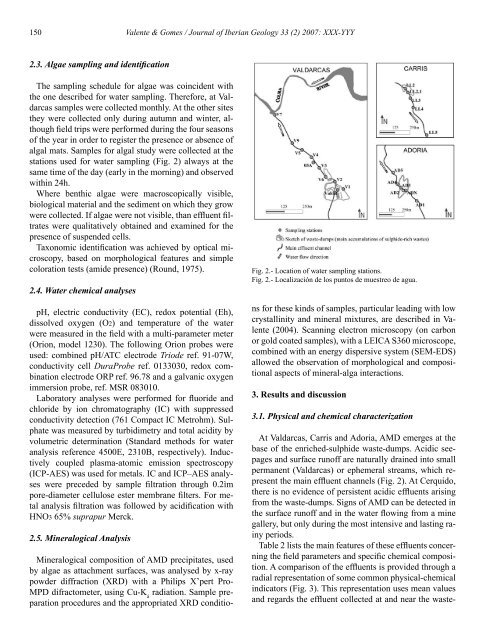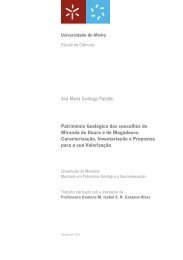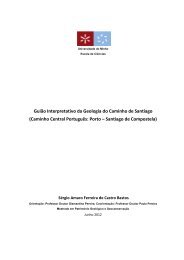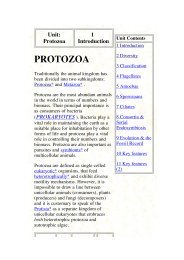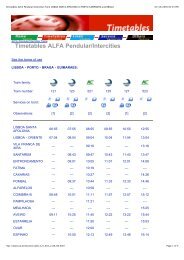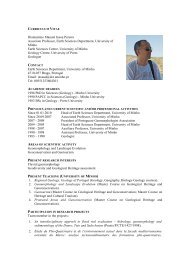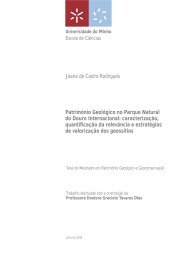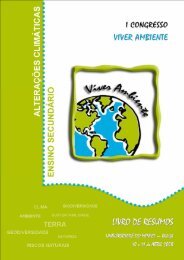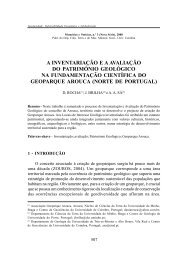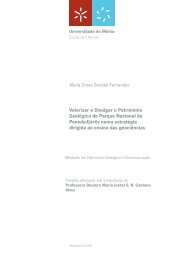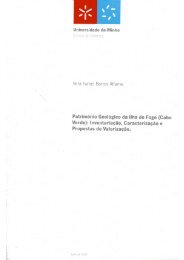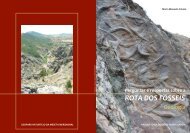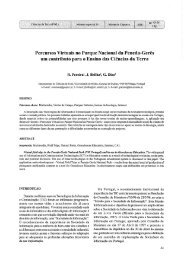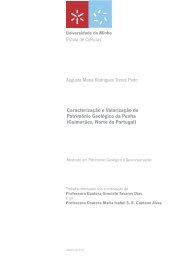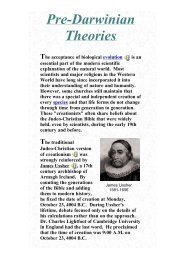Descarregue o Livro do Curso a partir daqui - Departamento de ...
Descarregue o Livro do Curso a partir daqui - Departamento de ...
Descarregue o Livro do Curso a partir daqui - Departamento de ...
You also want an ePaper? Increase the reach of your titles
YUMPU automatically turns print PDFs into web optimized ePapers that Google loves.
150 Valente & Gomes / Journal of Iberian Geology 33 (2) 2007: XXX-YYY<br />
2.3. Algae sampling and i<strong>de</strong>ntification<br />
The sampling schedule for algae was coinci<strong>de</strong>nt with<br />
the one <strong>de</strong>scribed for water sampling. Therefore, at Valdarcas<br />
samples were collected monthly. At the other sites<br />
they were collected only during autumn and winter, although<br />
field trips were performed during the four seasons<br />
of the year in or<strong>de</strong>r to register the presence or absence of<br />
algal mats. Samples for algal study were collected at the<br />
stations used for water sampling (Fig. 2) always at the<br />
same time of the day (early in the morning) and observed<br />
within 24h.<br />
Where benthic algae were macroscopically visible,<br />
biological material and the sediment on which they grow<br />
were collected. If algae were not visible, than effluent filtrates<br />
were qualitatively obtained and examined for the<br />
presence of suspen<strong>de</strong>d cells.<br />
Taxonomic i<strong>de</strong>ntification was achieved by optical microscopy,<br />
based on morphological features and simple<br />
coloration tests (ami<strong>de</strong> presence) (Round, 1975).<br />
2.4. Water chemical analyses<br />
pH, electric conductivity (EC), re<strong>do</strong>x potential (Eh),<br />
dissolved oxygen (O2) and temperature of the water<br />
were measured in the field with a multi-parameter meter<br />
(Orion, mo<strong>de</strong>l 1230). The following Orion probes were<br />
used: combined pH/ATC electro<strong>de</strong> Trio<strong>de</strong> ref. 91-07W,<br />
conductivity cell DuraProbe ref. 0133030, re<strong>do</strong>x combination<br />
electro<strong>de</strong> ORP ref. 96.78 and a galvanic oxygen<br />
immersion probe, ref. MSR 083010.<br />
Laboratory analyses were performed for fluori<strong>de</strong> and<br />
chlori<strong>de</strong> by ion chromatography (IC) with suppressed<br />
conductivity <strong>de</strong>tection (761 Compact IC Metrohm). Sulphate<br />
was measured by turbidimetry and total acidity by<br />
volumetric <strong>de</strong>termination (Standard methods for water<br />
analysis reference 4500E, 2310B, respectively). Inductively<br />
coupled plasma-atomic emission spectroscopy<br />
(ICP-AES) was used for metals. IC and ICP–AES analyses<br />
were prece<strong>de</strong>d by sample filtration through 0.2ìm<br />
pore-diameter cellulose ester membrane filters. For metal<br />
analysis filtration was followed by acidification with<br />
HNO3 65% suprapur Merck.<br />
2.5. Mineralogical Analysis<br />
Fig. 2.- Location of water sampling stations.<br />
Fig. 2.- Localización <strong>de</strong> los puntos <strong>de</strong> muestreo <strong>de</strong> agua.<br />
Mineralogical composition of AMD precipitates, used<br />
by algae as attachment surfaces, was analysed by x-ray<br />
pow<strong>de</strong>r diffraction (XRD) with a Philips X’pert Pro-<br />
MPD difractometer, using Cu-K á<br />
radiation. Sample preparation<br />
procedures and the appropriated XRD conditions<br />
for these kinds of samples, particular leading with low<br />
crystallinity and mineral mixtures, are <strong>de</strong>scribed in Valente<br />
(2004). Scanning electron microscopy (on carbon<br />
or gold coated samples), with a LEICA S360 microscope,<br />
combined with an energy dispersive system (SEM-EDS)<br />
allowed the observation of morphological and compositional<br />
aspects of mineral-alga interactions.<br />
3. Results and discussion<br />
3.1. Physical and chemical characterization<br />
At Valdarcas, Carris and A<strong>do</strong>ria, AMD emerges at the<br />
base of the enriched-sulphi<strong>de</strong> waste-dumps. Acidic seepages<br />
and surface runoff are naturally drained into small<br />
permanent (Valdarcas) or ephemeral streams, which represent<br />
the main effluent channels (Fig. 2). At Cerqui<strong>do</strong>,<br />
there is no evi<strong>de</strong>nce of persistent acidic effluents arising<br />
from the waste-dumps. Signs of AMD can be <strong>de</strong>tected in<br />
the surface runoff and in the water flowing from a mine<br />
gallery, but only during the most intensive and lasting rainy<br />
periods.<br />
Table 2 lists the main features of these effluents concerning<br />
the field parameters and specific chemical composition.<br />
A comparison of the effluents is provi<strong>de</strong>d through a<br />
radial representation of some common physical-chemical<br />
indicators (Fig. 3). This representation uses mean values<br />
and regards the effluent collected at and near the waste-


